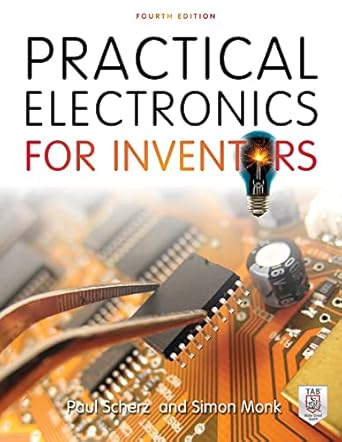Expanded Summary: "Practical Electronics for Inventors, Fourth Edition"
"Practical Electronics for Inventors, Fourth Edition" (published April 1, 2016) is a cornerstone resource for anyone seeking to build a strong foundation in electronics. It bridges the gap between introductory texts and advanced engineering manuals, offering a comprehensive and accessible guide for hobbyists, inventors, students, and early-career professionals. This book emphasizes practical, hands-on learning, making complex concepts understandable through clear explanations, detailed illustrations, and step-by-step instructions.
Key Features:
- Comprehensive Coverage: 17 chapters covering fundamental electronic components (resistors, capacitors, transistors), analog and digital circuits, microcontrollers, power electronics, and more.
- Practical Approach: Focuses on building and testing circuits, with numerous schematics and real-world examples.
- Updated Content: Includes new sections on programmable logic, semiconductors, operational amplifiers, and digital electronics, reflecting modern industry practices.
- Visual Learning: Abundant high-quality illustrations and diagrams to aid comprehension.
- Clear and Accessible Language: Presents complex topics in a straightforward manner, making it suitable for a wide range of learners.
Use Cases:
- Educational Foundation:
- Ideal for students in introductory electronics courses, providing a practical supplement to theoretical studies.
- Used by educators to demonstrate circuit behavior and reinforce key concepts.
- Prototyping and Invention:
- Enables inventors to design and build functional prototypes for their projects.
- Provides guidance on selecting components and troubleshooting circuits.
- Robotics and Automation:
- Covers motor control (DC, servo, stepper) and sensor integration, essential for robotics projects.
- Facilitates the development of automated systems using microcontrollers.
- Audio and Signal Processing:
- Explores audio amplifiers, microphones, and speakers, enabling the creation of custom audio devices.
- Introduces signal processing concepts for various applications.
- Power Electronics and Energy Systems:
- Provides insights into voltage regulation, power supplies, and energy storage, relevant to renewable energy and power management.
- Development of small solar powered devices.
- IoT (Internet of Things) Development:
- The microcontroller and sensor information is very helpful for developing small IoT devices.
- The digital logic sections help in the understanding of digital communications.
MATLAB Simulation Potential:
While "Practical Electronics for Inventors" focuses on physical circuit building, MATLAB and Simulink can complement its learning by:
- Circuit Simulation:
- Simulink's Simscape Electrical toolbox can model and simulate circuits described in the book, allowing for virtual testing and analysis.
- MATLAB can be used to analyze circuit behavior, such as frequency response and transient analysis.
- Signal Processing:
- MATLAB's Signal Processing Toolbox can be used to analyze and process signals from sensors and audio circuits.
- Simulate filter designs, and analyze signal waveforms.
- Control System Design:
- Simulink can model and simulate control systems for motor control and automation projects.
- Verify control loop stability.
- Data Analysis:
- Matlab can be used to analyze data collected from real world circuits.
- Create graphs and charts of data.
Key References and Context:
- General Electronics Education:
- "The Art of Electronics" by Paul Horowitz and Winfield Hill: A classic comprehensive electronics text.
- Online resources from institutions like MIT OpenCourseWare and Khan Academy.
- Microcontroller and Embedded Systems:
- Arduino and Raspberry Pi documentation and tutorials.
- Textbooks on embedded systems design.
- Circuit Simulation:
- MATLAB and Simulink documentation for Simscape Electrical.
- SPICE simulation software documentation.
- Industry and Community Resources:
- Websites and forums like Electronics Stack Exchange and Reddit's r/electronics.
- Datasheets from electronic component manufacturers.
Citations:
- Scherz, P., & Monk, S. (2016). Practical Electronics for Inventors, Fourth Edition. McGraw-Hill Education.
- https://www.goodreads.com/book/show/26271792
- https://mhebooklibrary.com/doi/book/10.1036/9781259587559
- https://mlp6.pages.oit.duke.edu/MedTech-Prototyping-Skills/Practical_Electronics_for_Inventors_Fourth_Edition_By_Paul_Scherz_and_Simon_Monk.pdf
This expanded summary aims to provide a more comprehensive overview of the book's value and its potential for integration with MATLAB simulation.



